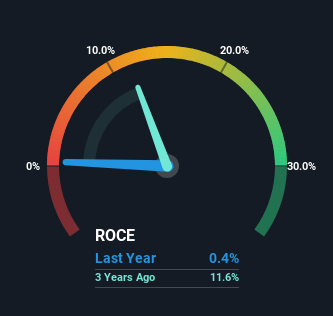- Israel
- /
- Specialty Stores
- /
- TASE:MRG
There Are Reasons To Feel Uneasy About Multi Retail Group's (TLV:MRG) Returns On Capital
If you're looking for a multi-bagger, there's a few things to keep an eye out for. Firstly, we'll want to see a proven return on capital employed (ROCE) that is increasing, and secondly, an expanding base of capital employed. Ultimately, this demonstrates that it's a business that is reinvesting profits at increasing rates of return. Having said that, from a first glance at Multi Retail Group (TLV:MRG) we aren't jumping out of our chairs at how returns are trending, but let's have a deeper look.
What Is Return On Capital Employed (ROCE)?
Just to clarify if you're unsure, ROCE is a metric for evaluating how much pre-tax income (in percentage terms) a company earns on the capital invested in its business. Analysts use this formula to calculate it for Multi Retail Group:
Return on Capital Employed = Earnings Before Interest and Tax (EBIT) ÷ (Total Assets - Current Liabilities)
0.0036 = ₪1.7m ÷ (₪851m - ₪386m) (Based on the trailing twelve months to December 2023).
Thus, Multi Retail Group has an ROCE of 0.4%. In absolute terms, that's a low return and it also under-performs the Specialty Retail industry average of 8.5%.
Check out our latest analysis for Multi Retail Group

While the past is not representative of the future, it can be helpful to know how a company has performed historically, which is why we have this chart above. If you're interested in investigating Multi Retail Group's past further, check out this free graph covering Multi Retail Group's past earnings, revenue and cash flow.
So How Is Multi Retail Group's ROCE Trending?
On the surface, the trend of ROCE at Multi Retail Group doesn't inspire confidence. Over the last five years, returns on capital have decreased to 0.4% from 26% five years ago. However it looks like Multi Retail Group might be reinvesting for long term growth because while capital employed has increased, the company's sales haven't changed much in the last 12 months. It's worth keeping an eye on the company's earnings from here on to see if these investments do end up contributing to the bottom line.
On a related note, Multi Retail Group has decreased its current liabilities to 45% of total assets. So we could link some of this to the decrease in ROCE. Effectively this means their suppliers or short-term creditors are funding less of the business, which reduces some elements of risk. Some would claim this reduces the business' efficiency at generating ROCE since it is now funding more of the operations with its own money. Keep in mind 45% is still pretty high, so those risks are still somewhat prevalent.
The Bottom Line On Multi Retail Group's ROCE
Bringing it all together, while we're somewhat encouraged by Multi Retail Group's reinvestment in its own business, we're aware that returns are shrinking. Moreover, since the stock has crumbled 77% over the last three years, it appears investors are expecting the worst. On the whole, we aren't too inspired by the underlying trends and we think there may be better chances of finding a multi-bagger elsewhere.
One more thing: We've identified 4 warning signs with Multi Retail Group (at least 2 which don't sit too well with us) , and understanding these would certainly be useful.
While Multi Retail Group isn't earning the highest return, check out this free list of companies that are earning high returns on equity with solid balance sheets.
New: Manage All Your Stock Portfolios in One Place
We've created the ultimate portfolio companion for stock investors, and it's free.
• Connect an unlimited number of Portfolios and see your total in one currency
• Be alerted to new Warning Signs or Risks via email or mobile
• Track the Fair Value of your stocks
Have feedback on this article? Concerned about the content? Get in touch with us directly. Alternatively, email editorial-team (at) simplywallst.com.
This article by Simply Wall St is general in nature. We provide commentary based on historical data and analyst forecasts only using an unbiased methodology and our articles are not intended to be financial advice. It does not constitute a recommendation to buy or sell any stock, and does not take account of your objectives, or your financial situation. We aim to bring you long-term focused analysis driven by fundamental data. Note that our analysis may not factor in the latest price-sensitive company announcements or qualitative material. Simply Wall St has no position in any stocks mentioned.
About TASE:MRG
Slight risk with imperfect balance sheet.
Market Insights
Community Narratives



